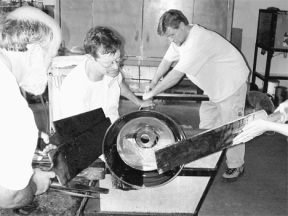If you talk to artists on the South End or glass artists in Seattle, they’ll tell you Rob Adamson is the “Godfather of Glassblowers.”
The Godfather’s work is on display now at MUSEO in downtown Langley through April 1.
In fact, there are many recognized glassblowers now working in the Pacific Northwest who were once students of this godfather of glass. Adamson was instrumental at the Pilchuck Glass School from 1974 through 1977 for turning out gifted students while holding a variety of directorial positions there.
He founded the nationally known art glass company, Glass Eye Studio, in 1978 in Seattle, and he stayed aboard as a designer after selling the company in 1989.
Since 1997, Adamson has focused on his own private glass facility on the island, and rewards himself with sculptural explorations in contemporary art glass.
Walk into his Freeland studio next to the Island Art Glass gift shop and you’ll see Adamson’s personal favorites: an array of oversized blown glass fruit including the yellowest of yellow lemons, ripe red cherries and several pears of varying shades of green. These whimsical fruits are lately in demand by glass art lovers and Adamson and his team must keep the fires burning to keep art lovers supplied. Visitors will also see an array of glass vases and bowls that have been painstakingly carved by the artist or are being prepared for carving.
“Carving is what I love to do,” Adamson said. “But it is extremely difficult and I have to press so hard on the glass that my fingers will go numb. One vase can take me about a month to finish.”
Carving is just one part of his work as a glass artist and after 35 years in the business, the pain it causes his hands is a hazard stoically suffered for the pleasure Adamson takes in the work.
It is common now for glass artists to work in teams. There are usually at least three to six people working in the Freeland studio at once, some finishing up one piece while the others get started on the next. It saves time and expense as glassblowing has many steps and more hands saves time and expensive materials.
After a piece has been blown Adamson may decide to carve the piece. He usually is inspired by nature and its seasonal effects.
In winter, for example, there is a minimalist quality. The trees are bare and before the plants have bloomed there is a certain absence of color. Thus, he said, in these colder months he works with clear glass.
He pulls out a previously carved vase of clear glass delicately etched with blades of grass. Opaque white, it has the color of winter frost.
But now that spring is looming, Adamson starts to look at colors by getting outside and drawing what he sees first before returning to the piece.
He covers the entire shape with four layers of thick tape. He then draws a design or pattern on the tape — one taped piece has the image of a snake swirling up and around the vase. Next he will start the arduous process of carving into the tape and glass with an Exacto knife. “It hurts,” he said, “but I love to do it.”
“When I was younger I would go for six or seven hours at a time. Not anymore,” Adamson said. “Now I work at it for an hour and then rest for 30 minutes. It’s a process.”
The carved pieces are visibly astounding in their craftsmanship and some of the larger, deep-etched pieces will sell from $8,000 to $20,000, though he has made the pieces for the current MUSEO show more affordable.
Adamson is an expert colorist and will sometimes “melt” his own colors. Because it is expensive and difficult to do, however, he usually buys his colors from a company in Germany which has been making color pigments for glassblowers for centuries.
He shows a small bowl that has a pink hue.
“This is a color I made,” Adamson said. It is a beautifully delicate color that reminds one of cherry blossoms in the spring. Adamson said such colors can make a difference when carving; each color is made with metallic oxide and some react differently. Some colors can cause the glass to break more easily.
“This pink is less compatible for carving. I’ve learned from experience,” he said.
Adamson’s personal designs are sold exclusively through MUSEO Gallery on First Street in Langley. He also co-partners local Island Art Glass with fellow glass artist Robert Hodges and wife Jan Swalwell. Hodges and Swalwell are a members of the studio team along with lead glass-blower and former Adamson student, Eric Lieberman and artists Dan Singleton and Dave Leonard.
Adamson speaks highly of his team like a godfather would, calling them all fine glass artists in their own right, a clue to his generosity of spirit and why he acquired the nickname in the first place.
Visit www.museo.cc or call 221-7737 for more information about the show or Adamson’s work. Island Art Glass gift shop is located at 2062 E. Newman Road in Freeland.



